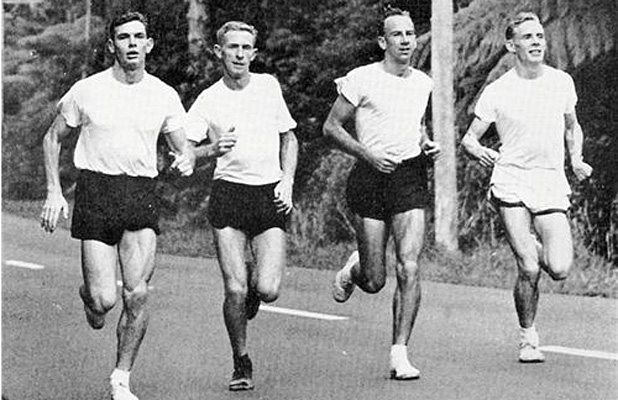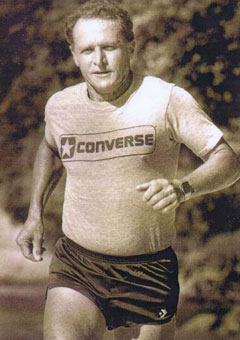Arthur Lydiard was the fore-father of periodisation in run training. He developed his own methodologies in the 1950’s and 60’s that lead to his athletes winning a range of Olympic medals from the 800m through to the marathon with Murray Halberg, Peter Snell, Barry Magee and John Davies. Arthur’s methodology is often misquoted or interpreted wrong. He was well known for long runs for ALL his athletes and this is what he is most often remembered for, but he was equally insistent on speed work. Let’s have a look at his methodology.
This is the first article to look at periodisation of a number of internationally influential coaches and their training methodology. Keep an eye out for next Monday’s article. Note that I spell periodisation the English way with an ‘s’, the American spelling is traditionally with a ‘z’.
Arthur had a number of discrete phases of his training:
- Marathon Conditioning Training
- Speed and Anaerobic Capacity
- Track Training
Marathon Conditioning Training
It is during this phase that Arthur aims to improve the efficiency of three factors:
- The ability to absorb oxygen from the air;
- Transport it to various muscles and organs; and
- Capacity to use said oxygen.
Results from this phase of training include a bigger and more powerful, it can pump more blood every beat and can also beat faster. Greater capillary beds within the lungs, which enables more oxygen to be absorbed more easily. Further more through sustained running for longer durations lays down more capillary beds within the muscles. This means that oxygen can be more easily delivered into the working muscle cells and exchanged for waste products to be removed from the muscle.
Towards the end of this phase Arthur recommends including some hill springing (or bounding), as well as steep hill running.
Arthur put ALL his athletes through this phase regardless of whether they were 800m runners or marathon runners. He wanted to maximise the aerobic conditioning of his athletes, so that regardless of how fast the opening pace was in an event, they were more aerobically fit than the other athletes and could literally save their legs (by not developing lactic acid) for the kick to the line.
His training schedules see this phase lasting as long as practicable before moving onto the remaining phases.
Speed and Anaerobic Capacity
In this phase of training Arthur tries to develop the capacity to exercise anaerobically and handle high oxygen debt. During this block of training the running will create fatigue levels which simulate your body metabolism to respond as a result of the level of effort.
The marathon conditioning phase has built your stamina and you will be ready to begin developing your speed and increasing your anaerobic capacity (both elements which were avoided in the Marathon Conditioning phase of training).
Hill springing continues throughout this phase as we aim to strengthen muscles, tendons and ligaments as well as put springiness into our calf muscles.
Anaerobic capacity is developed through the inclusion of wind sprints of up to 400m. The distance is limited to avoid over doing things in this phase. Nor have diminished performance due to excess fatigue due to the build up of waste products like lactic acid.
Arthur would alternate hills with wind sprints through the week and then have his athletes run long to round out the week.
Arthur states that this phase shouldn’t last longer than four to five weeks.
Track Training
“Without that preparation, track schedules are not worth the paper on which they are written.”
– Arthur Lydiard
With out developing the aerobic base in his Marathon Conditioning Phase, and then strengthening the body and exposing it to the wind sprints, this prepared the athlete for this final phase of training that built on everything that came before it. If that previous work wasn’t done, the results of going straight into the Track Training phase will be sub-par.
Speed is the primary importance in this phase. With that importance also come more intense, anaerobic activity.
Arthur recommends fast, relaxed speed over distances of 100 to 150m, with Rest Intervals (RIs) of at least three minutes, so each run you can hit your maximal speed, time and time again. He also suggests holding back on your pace a touch, so that it can continue to be raised as you work through the session.
Also included with in this phase are a range of workout styles that won’t be delved into in this article but all can and will play an important role depending on the nature of the event being prepared for. They include:
- Fartlek,
- Paarlauf,
- Time Trials,
- Repetitions,
- Sharpeners,
- Sprint training, and
- Starting practice.
The duration of this phase is for ten weeks prior to the major event that is being targeted, with the focus on the first 4-4½ weeks being on anaerobic capacity. This phase concludes with a tapering off of the training with the last hard effort 10 days prior to the event.
Lydiard’s 5 Principles
Arthur is also acknowledged with developing his training with five guiding principles.
- General Conditioning First,
- Response Regulated Training,
- Feeling Based Training,
- Sequential Development, and
- Peaking.
Any Lydiard programme starts with building the engine that is later fine tuned witht he general conditioning delivered by the Marathon Conditioning Training.
“Train, don’t strain.”
– Bill Bowerman (but often quoted by Arthur Lydiard)
This quote is very applicable for Response Regulated Training, as all training needs an element of smart application of common sense by ensuring you are ready for the training and aren’t over tired, or under the weather.
Lydiard was big fan of listening to your body, feeling and accurately interpreting the messages your body is giving you. We can receive a lot of data and information from training devices these days, but Lydiard wanted his athletes to understand their body internally rather than relying on times and numbers.
Training in the proper order is a key principle of Lydiard’s philosophy, moving from one phase to the next to ensure success. Contrast this to each week trying to include a little of every component of running fitness, so that you are constantly challenging the body.
Any programme prepared using Lydiard principles would see the programme build to a peak with the final phase of training delivering the body to peak fitness ready for the event.
Read more about Arthur Lydiard’s training philosophies in his book Running with Lydiard.
Since the success of his New Zealand athletes Snell, Halberg and Magee at the 1960 Rome Olympics, Arthur Lydiard’s name has been synonymous with the best training methods used by the world’s top middle and long-distance runners. Instructing runners in Finland, Mexico, Venezuela, Denmark, Japan, the USA and New Zealand, Lydiard has continued to refine his methods, and this manual contains information on exercise physiology, diet, injury prevention and cure, discussion of Lydiard’s methods and revised training schedules.


Very interesting. There is a tendency to think that today’s approaches are all new, whereas this indicates, that much of what we recommend today, isn’t that different from decades ago, but rather is backed up with greater physical and biological testing. Although not specifically mentioned he used RPE!
I’m currently interested in Paul Laursen work on applying HIIT as part of overall periodisation, I think he mainly uses polarised. He examines different types of interval training, of particular interest is his Myoglobin intervals, eg, high numbers of very short high intensity, eg, 5 sets of 10x 20sec+20sec.
Whereas Traditional periodisation details an entire plan, ie, how each stage and block is planned with its respective focus, I haven’t found that with Polarised periodisation discussions, so am confused about if every stage and block follows the same general plan, plus increasing overload each block?
The traditional periodisation ie, close to Lydiards approach, of beginning with Long low intensity with increasing specificity closer to the primary goal, has, IMO, greater applicability to Tri distance events, but less applicable to 70.3 and IM.
So, looking forward to your future periodisation articles.